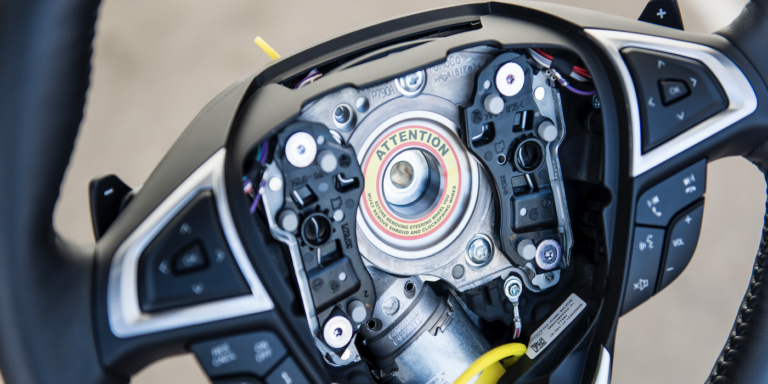Ford has been investigating adaptive steering technologies for some time. With its EPS tuning at a high level of maturity, it was keen to further improve steering performance and remove the compromise between low-speed agility and high-speed stability inherent in a mechanical ratio.
According to Lodewijk Wijffels, Ford’s technical specialist for adaptive steering, the rack- or column-based solutions such as those employed by Audi and BMW were rejected and the search continued for something more affordable, more modular and applicable to different vehicles with minimal changes.
The solution is a Takata-supplied system that fits in its entirety inside the steering wheel. After a couple of years of intensive development, it will feature on some of Ford’s CD cars: Edge, Galaxy, S-MAX and the Lincoln MKX.
“We put an electric motor, gearbox and ECU within a normal-sized steering wheel,” Wijffels explains. “We use that to provide an overlay. With the motor, we can add or subtract a steering angle to what the driver is doing, thereby changing the ratio between the steering wheel and the road wheels.”
Inside the steering wheel, an ECU carries all the software for the system (Ford has taken out around 15 patents in the software strategy, although the Takata hardware will not be exclusive to Ford). A clock spring with eight tapes takes care of power to the motor and ECU.
“On top of that, and because the primary input to the system is the steering wheel input from the driver, we have a very precise steering wheel angle sensor integrated into the system,” he says. “Normally there might be an angle sensor on the rack, but we need to know precisely what the driver’s doing.”
A vacuum-folded airbag sits on top of this compact package, which fits within the center volume of a regular steering wheel. Only the filled-in bottom spoke of the wheel gives away the presence of what has been branded Ford Adaptive Steering (FAS).
At low speed, the ratio (just under 15:1 as standard) is much more direct, offering around two turns lock-to-lock instead of the normal three. The system is always on and Wijffels says that as the vehicle speed rises, care has been taken to create a very distinct on-center position. “If you then steer further at higher speeds, we make the vehicle’s response to the driver’s input smoother. It’s fully blended in at all speeds and we have tried to optimize the ratio for all conditions.”
There’s also a tie-in with the optional Hitachi adaptive damping system. The three personalization settings of sport, normal and comfort now change the dampers, steering ratio and EPS power assistance. Six different calibrations of FAS are stored in its ECU to tie in with standard or sport suspension, with the appropriate three activated on the production line depending on the vehicle’s spec.
The three elements to the chassis setting are always linked, with no option to individually adjust one or the other. “It’s difficult to separate them, because if you change the damper setting by itself, you get different on-center behavior,” Wijffels argues.
“We’ve taken care in the tuning that the three systems are blended together very well. During the development it was important to us to provide a very natural feel, not to give the driver the feeling that a system was working in the background. Good steering feel is very important to Ford. We wanted to improve on it without introducing additional error states, so during the development with Takata, we set high requirements for steering feel and precision.”





